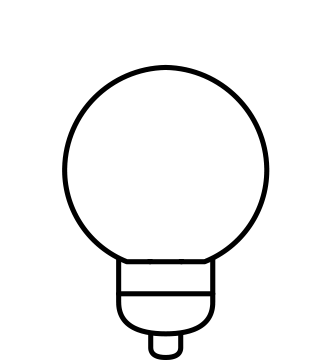/f/113144/1900x466/a475ac0c95/slv_good-light-solutions_hero-image_1900x466px_installation-tipps.jpg)
Sometimes it could be as simple as this: You have completed your project in the house and, since you have taken the precaution of including a buffer, you even have some recessed floor spotlights left over. Thus, you could actually continue right away in the outdoor area. Anyway, it would make a uniform picture if the recessed spotlights from the living room would also be found on the terrace. It would for sure! However, this is rarely a good idea. Because inside is not equal to outside and also the type of installation should be considered when choosing the right light.
In the driveway and garden, conditions are completely different. If it is warm and dry indoors, wet and cold await us outdoors - depending on the season. This also means completely different challenges for the installed luminaires. Challenges that you should take into account when selecting luminaires.
However, if you keep the following five points in mind, nothing will stand in the way of a successful lighting installation.
Rule 1: Material
Moisture lurks everywhere outside, and not just in the rain or cold. Excessive humidity in the summer also takes its toll on the luminaire body. It is therefore particularly important to use corrosion-resistant, i.e. rust-free material. Where the luminaire is installed in the garden or terrace is irrelevant. Only use lights that are made of stainless steel or aluminum, for example. Even with copper or brass you are on the safe side and do not have to worry about complaints.

Rule 2: Protection class
Water can damage the luminaire not only from the outside. If moisture penetrates inside the luminaire, this can lead not only to a defect but also to life-threatening injuries - and not only for children playing nearby. Therefore, all luminaires that you install outdoors must have a protection rating of at least IP44. Then splashing water, no matter from which direction, cannot harm them. However, near a pond or pool, you should go straight for IP65. Luminaires with this degree of protection are not even affected by water jets.
/f/113144/827x668/d0e436100d/all_slv_relaunch_icon-image-light-bulb_827x668px.png)
Rule 3: Connection
With the choice of the right material and protection class, you are on the safe side, especially regarding the appearance of the outdoor luminaire. Almost more important, however, is what you don't see right away: the right connection. Power cables and co. must also be protected from the weather and laid in cable ducts. In addition, not every cable is intended for installation in the ground. So make sure you use the right material here, too.
After all, it has the most important job: it supplies the installed lights with the necessary power. The connection of the luminaires to the power grid must therefore also be waterproof, of course. This is the only way to protect yourself and your customers from short circuits and their undesirable side effects.
Recessed floor luminaires present special challenges in this respect. Very few like standing water. If you install in-ground spotlights, you should never do so in depressions or recesses. You also need to provide drainage underneath the recessed box. If the humidity is very high during installation, moisture may accumulate inside the fixture. Therefore, it is better to postpone the installation until the next dry day.
Ground recessed spotlights bring special challenges to this. Very few like standing water. So never install them in depressions or recesses, and make sure there is drainage underneath the mounting box. If the humidity is very high during installation, moisture may accumulate inside the fixture. Therefore, it is better to postpone the installation until the next dry day.
Rule 4: Type of luminaire
We now know some basic characteristics that distinguish outdoor luminaires from indoor counterparts. Now it is necessary to use this knowledge correctly. In plain language, this means: make the right choice of outdoor luminaire based on the desired installation location. We are not only referring to protection class and material. The type of luminaire also plays a decisive role here.
If the luminaires serve as a wayfinding system, for example, this can narrow down the selection to recessed floor luminaires, path luminaires and bollard luminaires. It becomes even more detailed if the recessed ground luminaires are installed in the driveway and thus have to withstand the weight of different vehicles. But wall luminaires also serve a different purpose in the entrance area than perhaps on the terrace or balcony. So both functionality and appearance play essential roles here.
Include this in your planning and opt for sensor lights wherever there are paths, for example.
Rule 5: Uniform photograph
If different installation locations also require different luminaire types, this does not necessarily mean that you have to do without a uniform light and luminaire image. SLV's product families are characterized by the fact that a uniform luminaire design is reflected in different luminaire types. So you get ceiling, wall and floor luminaires in the same look and thus create a uniform light image. Above all, this ensures peace in the eye of the beholder and a pleasant atmosphere.
With expertly installed surface-mounted and recessed lights and poles from SLV, your customers can feel more than at home outdoors thanks to high-quality materials and the necessary protection classes – and you are on the safe side.
 ФИЛИАЛЫ SLV
ФИЛИАЛЫ SLV













 SLV INTERNATIONAL
SLV INTERNATIONAL
/f/113144/585x287/9e989ab4d5/slv_good-light-solutions_image-text-teaser_enola_585x287px.jpg)
/f/113144/585x287/50a4ba6100/slv_good-light-solutions_image-text-teaser_50-50-small_585x287px_rocci.png)
/f/113144/373x296/4f97463af3/slv_good-light-solutions_grid-3_373x296px_einbaustrahler-senken.jpg)
/f/113144/373x296/000eaec0e8/slv_good-light-solutions_grid-3_373x296px_einbaustrahler-ebenen.jpg)
/f/113144/373x296/e8fe9b2576/slv_good-light-solutions_grid-3_373x296px_einbaustrahler-anhoehen.jpg)
/f/113144/585x287/f513558c05/slv_good-light-solutions_image-text-teaser_50-50-small_585x287px_quadrulo.png)
/f/113144/585x287/906422aa18/slv_good-light-solutions_image-text-teaser_50-50-small_585x287px_eskina-frame.png)
/f/113144/827x668/2b02efde7e/all_slv_good-light-solutions_overview-teaser-natural-material_827x668px.jpg)
/f/113144/827x668/5180090e9e/all_slv_good-light-solutions_overview-teaser-rusty_827x668px.jpg)
/f/113144/827x668/3c58237bc2/all_slv_good-light-solutions_overview-teaser-stainless-steel_827x668px.jpg)
